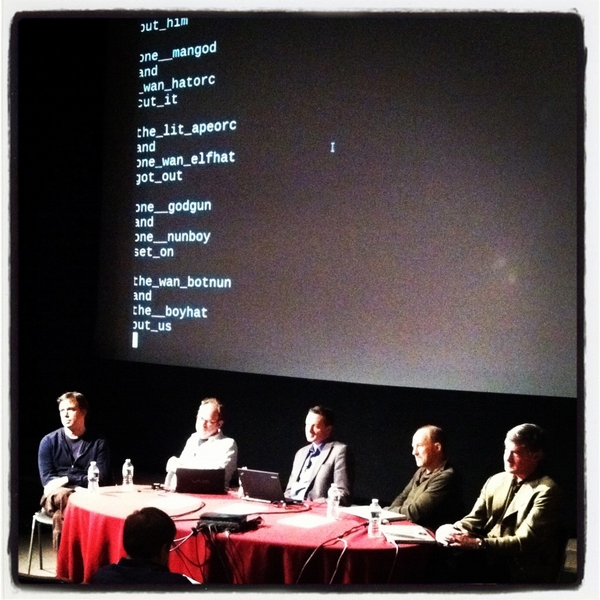MIT Visiting Artist Ben Houge led a panel on "Sound and Real-Time Systems," held in Bartos Theater on Feb. 15 at 7 p.m., where he was joined by members of the MIT community to discuss the convergence between the disciplines of video games, digital media and music composition.
To underscore these connections, panelists shared their experience in a range of fields: Joe Paradiso, an associate professor in the Media Lab, presented the origins and features of his impressive modular synthesizer, newly installed at the MIT Museum; Evan Ziporyn, Kenan Sahin Distinguished Professor of Music and Theater Arts, and David Cossin — both Bang on a Can All-Stars — described their experiences in performance and composition; and Nick Montfort, associate professor in the Program in Writing and Humanistic Studies, provided insights into several different media environments including text generation and game engines. A spirited discussion with the audience concluded the event when panelists fielded questions ranging from randomness and constraint in composition to the nuts and bolts of creating soundtracks for video games. The event was moderated by Leila Kinney, executive director of arts initiatives at MIT.
Houge’s opening presentation included highlights from his dynamic career as a composer and his work as a visiting artist with the Media Lab’s Responsive Environments Group. He showed a dynamic graphic of the Media Lab building that displayed audible output of real-time sensor data being collected on the spot. A highlight of the evening was Houge’s explanation of various compositional structures for video games, which he demonstrated by playing clips from James Brown, Olivier Messiaen and a 13th century chant composed by Pérotin, an early polyphonic composer.
The panel was part of Houge's residency at MIT — which took place from Jan. 10 through Feb. 15 — where he worked on sonifying networked sensor data as part of the DoppelLab project. During MIT’s Independent Activity Period, Houge led a student workshop that provided an overview of audio design for video games, while exploring how these techniques can be applied to other real-time digital experiences.
“I feel like my work is very much about finding points of convergence between different disciplines, and it’s been particularly fulfilling to explore the overlap between my work in video games and the research going on in the Responsive Environments Group,” Houge said. “In a lot of ways, we’re looking at the same kinds of things, coordinating different types of information in a virtual environment to convey some kind of cohesive experience.”
Houge works at the nexus of sound installation, music composition, video games, digital art and performance. A 15-year veteran of the video-game industry, his work investigates questions of real-time, non-linear structure. The MIT Visiting Artist Program brings internationally acclaimed artists to engage with MIT’s creative community in ways that are mutually enlightening for the artists and faculty, students, and research staff at the Institute.
To underscore these connections, panelists shared their experience in a range of fields: Joe Paradiso, an associate professor in the Media Lab, presented the origins and features of his impressive modular synthesizer, newly installed at the MIT Museum; Evan Ziporyn, Kenan Sahin Distinguished Professor of Music and Theater Arts, and David Cossin — both Bang on a Can All-Stars — described their experiences in performance and composition; and Nick Montfort, associate professor in the Program in Writing and Humanistic Studies, provided insights into several different media environments including text generation and game engines. A spirited discussion with the audience concluded the event when panelists fielded questions ranging from randomness and constraint in composition to the nuts and bolts of creating soundtracks for video games. The event was moderated by Leila Kinney, executive director of arts initiatives at MIT.
Houge’s opening presentation included highlights from his dynamic career as a composer and his work as a visiting artist with the Media Lab’s Responsive Environments Group. He showed a dynamic graphic of the Media Lab building that displayed audible output of real-time sensor data being collected on the spot. A highlight of the evening was Houge’s explanation of various compositional structures for video games, which he demonstrated by playing clips from James Brown, Olivier Messiaen and a 13th century chant composed by Pérotin, an early polyphonic composer.
The panel was part of Houge's residency at MIT — which took place from Jan. 10 through Feb. 15 — where he worked on sonifying networked sensor data as part of the DoppelLab project. During MIT’s Independent Activity Period, Houge led a student workshop that provided an overview of audio design for video games, while exploring how these techniques can be applied to other real-time digital experiences.
“I feel like my work is very much about finding points of convergence between different disciplines, and it’s been particularly fulfilling to explore the overlap between my work in video games and the research going on in the Responsive Environments Group,” Houge said. “In a lot of ways, we’re looking at the same kinds of things, coordinating different types of information in a virtual environment to convey some kind of cohesive experience.”
Houge works at the nexus of sound installation, music composition, video games, digital art and performance. A 15-year veteran of the video-game industry, his work investigates questions of real-time, non-linear structure. The MIT Visiting Artist Program brings internationally acclaimed artists to engage with MIT’s creative community in ways that are mutually enlightening for the artists and faculty, students, and research staff at the Institute.













